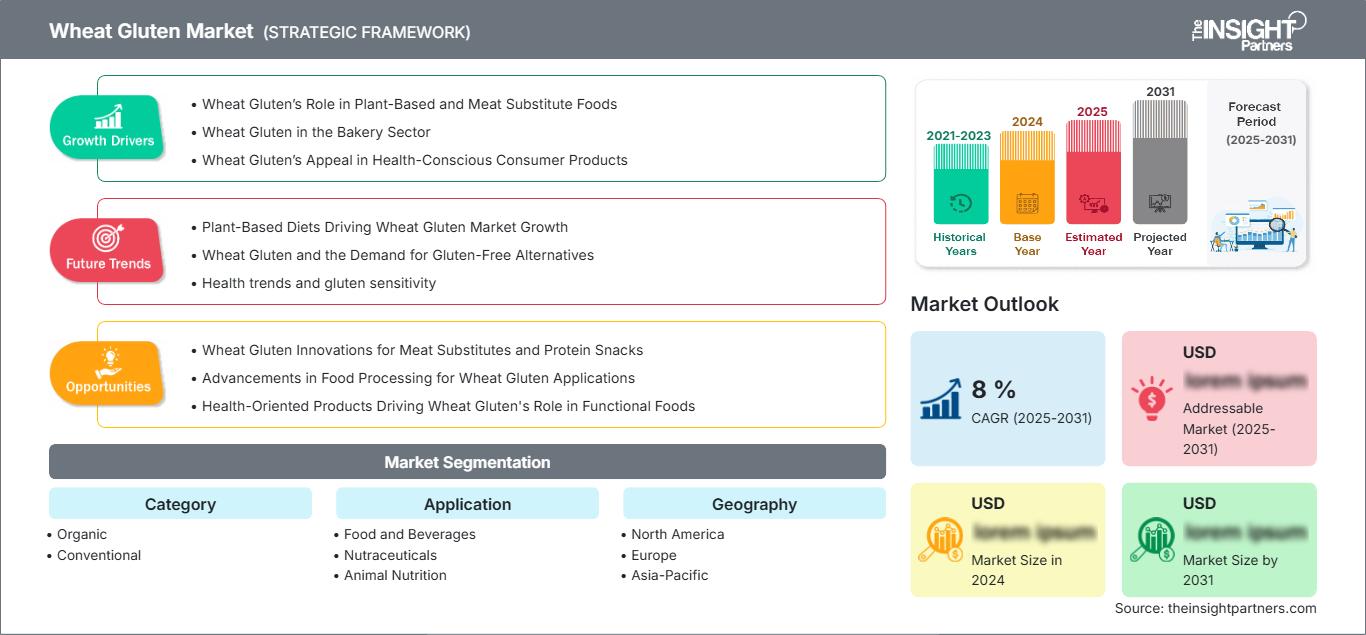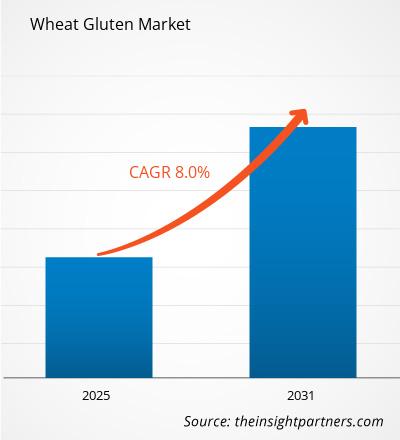Se espera que el mercado de gluten de trigo registre una CAGR del 8 % entre 2025 y 2031, con un tamaño de mercado que se expandirá de US$ XX millones en 2024 a US$ XX millones en 2031.
El informe está segmentado por categoría (orgánico, convencional). Además, presenta un análisis basado en la aplicación (alimentos y bebidas, nutracéuticos, nutrición animal, otros). El análisis global se desglosa a nivel regional y por países principales. Geográficamente, el mercado se divide en América del Norte, Europa, Asia Pacífico, Oriente Medio y África, y América del Sur y Central. El informe ofrece el valor en USD para el análisis y los segmentos mencionados.
Propósito del Informe
El informe "Mercado de Gluten de Trigo" de The Insight Partners busca describir el panorama actual y el crecimiento futuro, los principales factores impulsores, los desafíos y las oportunidades. Esto proporcionará información a diversas partes interesadas del negocio, como:
- Proveedores/fabricantes de tecnología: Para comprender la dinámica cambiante del mercado y conocer las oportunidades potenciales de crecimiento, lo que les permitirá tomar decisiones estratégicas informadas.
- Inversores: Realizar un análisis exhaustivo de tendencias respecto a la tasa de crecimiento del mercado, las proyecciones financieras del mercado y las oportunidades que existen en toda la cadena de valor.
- Órganos reguladores: Regular las políticas y las actividades policiales en el mercado con el objetivo de minimizar el abuso, preservar la confianza de los inversores y defender la integridad y estabilidad del mercado.
Segmentación del mercado del gluten de trigo
Categoría
- Orgánico
- Convencional
Solicitud
- Alimentos y bebidas
- Nutracéuticos
- Nutrición animal
- Otros
Obtendrá personalización en cualquier informe, sin cargo, incluidas partes de este informe o análisis a nivel de país, paquete de datos de Excel, así como también grandes ofertas y descuentos para empresas emergentes y universidades.
Mercado del gluten de trigo: Perspectivas estratégicas

-
Obtenga las principales tendencias clave del mercado de este informe.Esta muestra GRATUITA incluirá análisis de datos, desde tendencias del mercado hasta estimaciones y pronósticos.
Factores que impulsan el crecimiento del mercado del gluten de trigo
- El papel del gluten de trigo en los alimentos vegetales y sustitutos de la carne: La creciente tendencia hacia la venta al por mayor de alimentos vegetales está incrementando la demanda de gluten de trigo, rico en proteínas y versátil. Dado que los consumidores buscan sustitutos de la carne, el gluten de trigo se utiliza ahora de diversas maneras, incluyendo sustitutos de la carne y snacks ricos en proteínas, lo que contribuye al crecimiento del mercado.
- Gluten de trigo en el sector de la panadería: El sector de la panadería, que utiliza gluten para mejorar la consistencia y la elasticidad de la masa, impulsa el crecimiento del mercado del gluten de trigo. Con el aumento del consumo per cápita de pan y otros productos horneados a nivel mundial, se prevé un aumento en la demanda de gluten de trigo, lo que impulsará el crecimiento de este mercado.
- El atractivo del gluten de trigo en productos de consumo saludables: Existe un aumento notable en la concienciación sobre la salud entre las personas; por lo tanto, existe una tendencia a buscar recursos dietéticos funcionales. Dado que el gluten de trigo es una fuente rica en proteínas y fibra, se ha producido un cambio hacia el desarrollo de productos más saludables, lo que a su vez genera nuevos cambios positivos en el mercado.
Tendencias futuras del mercado del gluten de trigo
- Las dietas basadas en plantas impulsan el crecimiento del mercado del gluten de trigo: Existe un crecimiento considerable en la tendencia de las dietas basadas en plantas, que lideran el mercado del gluten de trigo para su uso en sustitutos de carne y alimentos enriquecidos con proteínas. Sin embargo, este desarrollo responde a la cambiante actitud del consumidor hacia alimentos saludables y respetuosos con el medio ambiente, lo que amplía aún más el alcance del mercado e impulsa su crecimiento.
- Gluten de trigo y la demanda de alternativas sin gluten: La población es cada vez más consciente de los problemas de salud relacionados con el gluten, ya sea la enfermedad celíaca o la intolerancia al gluten, lo que facilita la definición del mercado objetivo para los productos sin gluten. Esta tendencia influye en la innovación y el comportamiento del consumidor de los productores, lo que los lleva a buscar maneras de producir productos sin gluten y, al mismo tiempo, productos con gluten de trigo.
- Tendencias de salud y sensibilidad al gluten: Las dietas sin gluten están ganando popularidad entre las personas alérgicas o sensibles al gluten. Por ello, los fabricantes están reorientando su enfoque hacia el desarrollo de productos con menor contenido de gluten para los consumidores que buscan productos bajos en gluten.
Oportunidades de mercado del gluten de trigo
- Innovaciones en gluten de trigo para sustitutos de carne y snacks proteicos: A medida que más personas practican el vegetarianismo, aumenta la demanda de innovaciones alimentarias basadas en gluten de trigo, especialmente para el desarrollo de sustitutos de carne y snacks ricos en proteínas. Esto se debe a su fácil elaboración en formas texturizadas y a su alto contenido proteico, un aspecto atractivo para los fabricantes de alimentos que se dirigen a este grupo de consumidores.
- Avances en el procesamiento de alimentos para aplicaciones de gluten de trigo: Además, los avances en el procesamiento de la industria alimentaria y las tecnologías de vanguardia abren la puerta a la invención de nuevas propiedades del gluten de trigo. Estas pueden incluir mejoras en la composición de pasteles, fideos, etc., lo que permitirá a los productores adaptarse a las cambiantes demandas del mercado de productos alimenticios limpios, saludables y funcionales.
- Productos saludables que impulsan el papel del gluten de trigo en los alimentos funcionales: En cuanto a la demanda de productos alimenticios saludables, el mercado de alimentos funcionales está creciendo principalmente debido al cambio en el comportamiento del consumidor. Esto también se debe a que el gluten de trigo es una buena fuente de proteínas y fibra, por lo que se podrían desarrollar más productos saludables que lo incluyan como materia prima esencial, en línea con las nuevas tendencias en salud.
Perspectivas regionales del mercado del gluten de trigo
Los analistas de The Insight Partners han explicado detalladamente las tendencias regionales y los factores que influyen en el mercado del gluten de trigo durante el período de pronóstico. Esta sección también analiza los segmentos y la geografía del mercado del gluten de trigo en América del Norte, Europa, Asia Pacífico, Oriente Medio y África, y América del Sur y Central.
Alcance del informe de mercado del gluten de trigo
| Atributo del informe | Detalles |
|---|---|
| Tamaño del mercado en 2024 | US$ XX millones |
| Tamaño del mercado en 2031 | US$ XX millones |
| CAGR global (2025-2031) | 8 % |
| Datos históricos | 2021-2023 |
| Período de pronóstico | 2025-2031 |
| Segmentos cubiertos |
Por categoría
|
| Regiones y países cubiertos |
América del norte
|
| Líderes del mercado y perfiles de empresas clave |
|
Densidad de actores del mercado del gluten de trigo: comprensión de su impacto en la dinámica empresarial
El mercado del gluten de trigo está creciendo rápidamente, impulsado por la creciente demanda del consumidor final debido a factores como la evolución de las preferencias de los consumidores, los avances tecnológicos y un mayor conocimiento de los beneficios del producto. A medida que aumenta la demanda, las empresas amplían su oferta, innovan para satisfacer las necesidades de los consumidores y aprovechan las tendencias emergentes, lo que impulsa aún más el crecimiento del mercado.

- Obtenga una descripción general de los principales actores clave del mercado del gluten de trigo
Puntos clave de venta
- Cobertura integral: el informe cubre de manera integral el análisis de productos, servicios, tipos y usuarios finales del mercado de gluten de trigo, proporcionando un panorama holístico.
- Análisis de expertos: el informe se compila con base en el conocimiento profundo de expertos y analistas de la industria.
- Información actualizada: El informe asegura relevancia comercial debido a su cobertura de información reciente y tendencias de datos.
- Opciones de personalización: este informe se puede personalizar para satisfacer los requisitos específicos del cliente y adaptarse adecuadamente a las estrategias comerciales.
Por lo tanto, el informe de investigación sobre el mercado del gluten de trigo puede ayudar a descifrar y comprender el panorama de la industria y sus perspectivas de crecimiento. Si bien existen algunas preocupaciones válidas, las ventajas generales de este informe suelen superar las desventajas.
- Análisis histórico (2 años), año base, pronóstico (7 años) con CAGR
- Análisis PEST y FODA
- Tamaño del mercado, valor/volumen: global, regional y nacional
- Industria y panorama competitivo
- Conjunto de datos de Excel
Informes recientes
Informes relacionados
Testimonios
Razón para comprar
- Toma de decisiones informada
- Comprensión de la dinámica del mercado
- Análisis competitivo
- Información sobre clientes
- Pronósticos del mercado
- Mitigación de riesgos
- Planificación estratégica
- Justificación de la inversión
- Identificación de mercados emergentes
- Mejora de las estrategias de marketing
- Impulso de la eficiencia operativa
- Alineación con las tendencias regulatorias






















 Obtenga una muestra gratuita para - Mercado del gluten de trigo
Obtenga una muestra gratuita para - Mercado del gluten de trigo